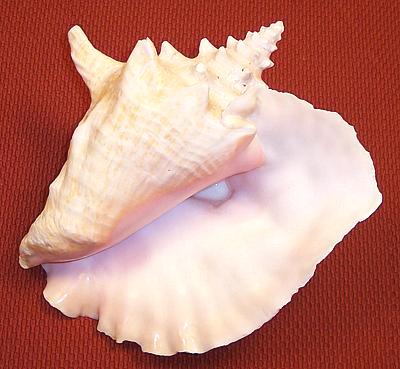 [Pink Conch, Tricornis gigas]
[Pink Conch, Tricornis gigas]
Pronounced "konk", this snail is found throughout the greater Caribbean region from South Carolina to Venezuela and around the Atlantic island of Bermuda. They can grow to about 13 inches long but the photo specimen is 8-1/2 inches. They reach sexual maturity in about three years when they will be about 8 inches long and weigh about 2 pounds.
Long an important food item in Caribbean it is now in serious decline throughout its range. Because much of the region's population is poor and lacks education local fishery controls are often ineffective so international trade sanctions are in effect. It is illegal to take any queen conch in U.S. waters or to import them, their meat, shells or products made from them from a number of countries. Import from some countries is still allowed but it's becoming rather expensive due to scarcity. Details at U.S. Fish and Wildlife Service (Note-1).
Restocking efforts have failed because captive grown conch lack survival instincts and are immediately eaten when placed in the ocean. It has recently been discovered that queen conch are turned on by pheromones drifting over from wildly mating conch of another species causing them to mate and spawn. This opens the possibility of closed cycle aquaculture.
More on Snails.
I do not encourage eating this snail because of its rapidly declining population.
A 2 pound conch will yield about 7 ounces of edible flesh which is very tough and needs a lot of pounding or a long soak in lemon juice to make it edible.
Cooking conch follows the same rules as for squid. Cook it very briefly or for a long time because after a brief cooking it becomes tough and takes long cooking to become tender again. As with squid the flavor will also be affected by long cooking so you must sample to prevent overcooking.
Most conch fishers remove the meat by knocking a hole in the shell at a particular point and cutting the adductor muscle. Conch can be removed without damaging the shell by placing it in salted water, bringing the water to a boil and boiling for about 10 minutes, more or less depending on size. Another method is by freezing overnight, then thawing and pulling the body out of the shell.
sf_gpconqz 061017 - www.clovegarden.com